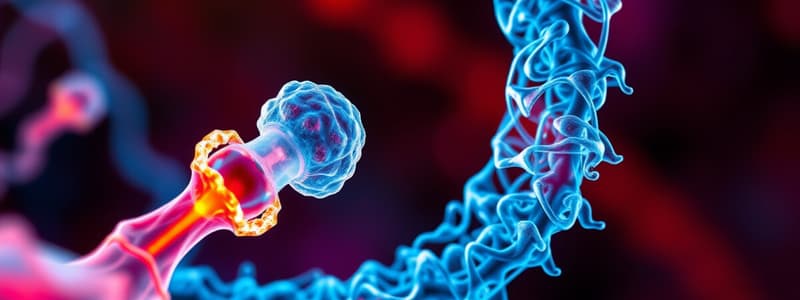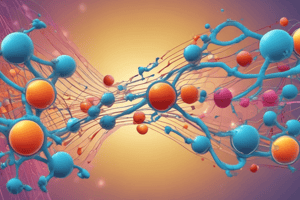Podcast
Questions and Answers
What is the primary purpose of the citric acid cycle?
What is the primary purpose of the citric acid cycle?
- To generate ATP directly
- To convert NADH into FADH2
- To produce glucose from pyruvate
- To break down acetyl-CoA into carbon dioxide (correct)
Where does oxidative phosphorylation occur?
Where does oxidative phosphorylation occur?
- Cytoplasm
- Ribosome
- Nucleus
- Inner mitochondrial membrane (correct)
Which process directly uses the proton gradient to produce ATP?
Which process directly uses the proton gradient to produce ATP?
- Glycolysis
- Citric acid cycle
- Chemiosmosis (correct)
- Fermentation
What role does oxygen play in the electron transport chain?
What role does oxygen play in the electron transport chain?
How many ATP molecules are produced from one molecule of glucose in total?
How many ATP molecules are produced from one molecule of glucose in total?
What is produced when protons flow back into the mitochondrial matrix?
What is produced when protons flow back into the mitochondrial matrix?
What happens to ATP production without oxygen?
What happens to ATP production without oxygen?
What substance is generated in the electron transport chain as a byproduct?
What substance is generated in the electron transport chain as a byproduct?
Which enzyme is responsible for synthesizing ATP during chemiosmosis?
Which enzyme is responsible for synthesizing ATP during chemiosmosis?
What is the function of the electron transport chain in cellular respiration?
What is the function of the electron transport chain in cellular respiration?
What is the primary fuel used by cells to generate energy?
What is the primary fuel used by cells to generate energy?
What are the three main stages of cellular respiration?
What are the three main stages of cellular respiration?
Where does glycolysis occur within the cell?
Where does glycolysis occur within the cell?
What is the end product of glycolysis along with ATP?
What is the end product of glycolysis along with ATP?
Which phase of glycolysis uses two ATP molecules?
Which phase of glycolysis uses two ATP molecules?
What is produced during pyruvate oxidation?
What is produced during pyruvate oxidation?
How many ATP molecules are produced by glycolysis from one glucose molecule?
How many ATP molecules are produced by glycolysis from one glucose molecule?
Which molecule acts as the electron carrier produced during glycolysis?
Which molecule acts as the electron carrier produced during glycolysis?
What phase of cellular respiration occurs in the mitochondrial matrix?
What phase of cellular respiration occurs in the mitochondrial matrix?
Which of the following statements is true about glycolysis?
Which of the following statements is true about glycolysis?
Flashcards are hidden until you start studying
Study Notes
Overview of Energy Requirements
- Cellular functions rely on energy derived primarily from glucose breakdown through cellular respiration.
- Glucose serves as the main fuel source for cells, utilized directly or stored as glycogen.
Cellular Respiration Process
- Comprises three main stages: glycolysis, citric acid cycle (Krebs cycle), and oxidative phosphorylation.
- ATP (adenosine triphosphate) is produced, serving as the energy currency for cellular activities.
Glycolysis (Occurs in the Cytoplasm)
- Anaerobic process that breaks down one glucose molecule into two pyruvate molecules.
- Preparatory Phase:
- Five initial steps involving phosphorylation of glucose by hexokinase to form glucose-phosphate.
- Requires two ATP molecules to initiate the process.
- Payoff Phase:
- Another five steps leading to ATP production through the conversion of glyceraldehyde-3-phosphate (G3P) to 1,3-bisphosphoglycerate.
- Results in a net output of two ATP, two NADH, and two pyruvate for the mitochondria.
Citric Acid Cycle (Occurs in the Mitochondria)
- Pyruvate from glycolysis is converted into acetyl-CoA before entering the citric acid cycle.
- Produces CO2 as waste and generates additional NADH.
- Acetyl-CoA is broken down releasing NADH and FADH2, which are crucial for ATP synthesis.
Oxidative Phosphorylation (Occurs in the Mitochondria)
- Final stage of ATP generation, occurring across the inner mitochondrial membrane.
- Involves two key processes: the Electron Transport Chain (ETC) and Chemiosmosis.
Role of the Mitochondria in ATP Generation
- Mitochondria act as the cell's powerhouses, primarily generating ATP through oxidative phosphorylation.
Electron Transport Chain (ETC)
- NADH and FADH2 donate electrons to the ETC composed of four complexes (I-IV).
- Electron transfer through redox reactions pumps protons (H+ ions) into the intermembrane space, establishing a proton gradient.
Chemiosmosis and ATP Synthesis
- The energy from the proton gradient drives ATP synthase to produce ATP from ADP and inorganic phosphate (Pi).
- Protons flow back to the mitochondrial matrix, facilitating ATP synthesis.
Final Electron Acceptors
- Oxygen is the final electron acceptor, forming water when combined with electrons and protons.
- Lack of oxygen halts the electron transport chain, ceasing ATP production, potentially leading to cell death.
Summary of ATP Yield
- Total ATP production from one glucose molecule can reach approximately 30-32 ATP through glycolysis, the citric acid cycle, and oxidative phosphorylation.
Key Takeaways
- Glycolysis produces a modest amount of ATP (2 ATP) and prepares intermediates for further processes.
- The Citric Acid Cycle contributes electron carriers (NADH and FADH2) and some ATP.
- Most ATP is generated during oxidative phosphorylation, predominantly due to the ETC and chemiosmosis.
Studying That Suits You
Use AI to generate personalized quizzes and flashcards to suit your learning preferences.




